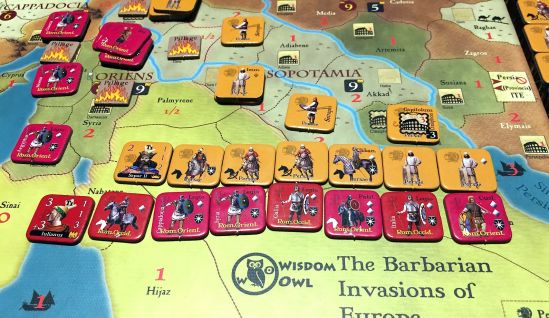After the successful Kickstarter campaign and then an over a year delay, the Invasions: Volume 1 – 350-650 AD finally arrived at our doorsteps. I will not deny it – I was awaiting the game anxiously and anticipated a lot from it – in the end, the author had to do a lot with Europa Universalis, one of my favorite Video Game franchisee. Let us see now how it turned out.
The Game
First, couple of words about the game and its component. Invasions simulates 600 years of European history, from 350 to 950 AD more or less. It will be split in two parts, first focusing on the early period till 600 AD.

During this period, known as the Dark Ages, many peoples invaded the continent, each hoping to colonize it or conquer a realm there, replacing other peoples established before them. But the new conquerors would never maintain their new powers for long, as they were also themselves invaded by other and newer peoples. This game ends by the time those great migrations ended.
In Invasions, each player controls many different peoples. Each of them strives to carve a realm at the best possible location, in view of historical objectives assigned by the rules. Some will prevail and found strong kingdoms and prosperous empires…others will vanish in the void of history.
And now the promised components – it is really worth checking them:




Julian Scenario – 350 AD
To give the game a try, we decided to play the smallest possible scenario – one created as extra one, which proved to be best intro into the system. It is pity to say it had tons of errors, but the corrected version is now on BGG.
We play on very small part of the map, with two nations – Eastern Romans and Persians. The topic – fateful Julian the Apostate war with Easterners which was his undoing. Points for control of the territories, pillaging the cities and killing enemies. Sassanids get tons of points for Syria and Palestine (they go first) and then there is Roman turn which will bring them most VPs for conquering the Ctesiphon – Persian capital. Let us see how it went in below photo-session report!







Small, quick and informative scenario. You should definitely start your experience with Invasions from it as it only requires Military and Victory Points rules.
The Impressions
Well, not as good as I wish they were. Let us start from positives.
- There is a great idea behind the game – depicting and reenacting volatile times of the Roman Empire collapse and widespread migrations of the tribes. The game aims to address all key aspects like administration, economy, diplomacy, military – accompanied by special rules to each barbarian or civilized group. You have possibility to lead couple of nations simultaneously, giving even more chrome to the game.
- The tokens are thick, rounded and very thematic. You can see a lot of thinking was put to that area. Map is beautiful and detailed, although the areas borders are very poorly printed.
- I also would like to underline that author was listening to the feedback of players – fortunately, we have extra scenarios which allow us to learn the game in digestible chunks, not as a big bang.
Ok, so what did not go so well?
- I think the project is so huge and complex, that it seems more like a computer game not a board one. To be able to cope with all the rules and all the exceptions is possible, but time consuming. I am not sure how much the full game, with 4 players, all rules and nations, will take.
- The way rules are written is not helping – there are errors, they use Roman rather than Arabic numbering and in many cases the wording is pretty ambiguous.
- As for graphics, I do not like when unit names overlap with the figure as it makes the inscription unreadable. Also, using different naming in rules, scenarios and player Aid’s (see Colchis!) is not helping.
- I would appreciate – like in Mark’s Herman Pericles – a gradual approach to teaching new players the game; so we read part of the rulebook and than we have appropriate scenario; fortunately, there was a last moment attempt to address this with Extra Scenarios, but even here the amount of error and ambiguity forced community to correct them.
There are many more points which I decided to leave for now. I need to play – or try to play – the game more before formulating more conclusions. The question is – shall you put the game on the shelf and wait for massive errata? I would say no, try to play two small scenarios (of course, with corrections!) – Julius and Brittania Scenarios to get the taste of the game. Then, you may decide if to wait for Living Rules or try something larger in scope, like another scenario.


Reblogged this on Paul Hodson.
LikeLiked by 1 person
It looks like Britannia+ – is that a fair comment?
LikeLiked by 1 person
Yes, a lot of similarities to Britannia but much more rules. Which not necessarily did good the game.
LikeLike